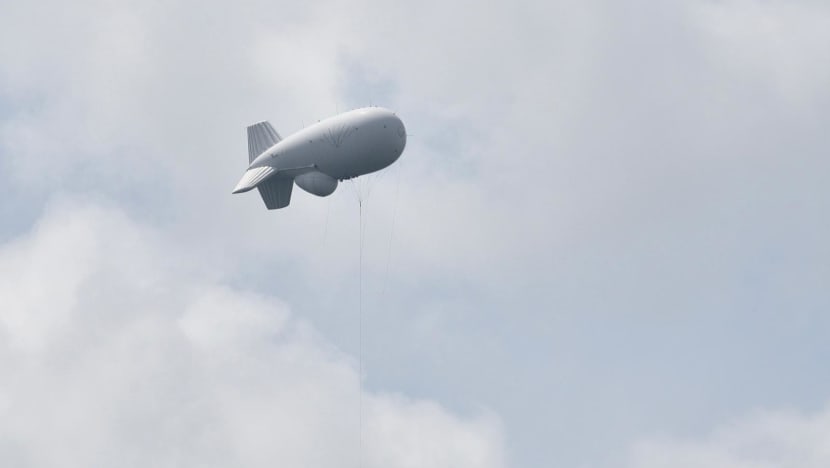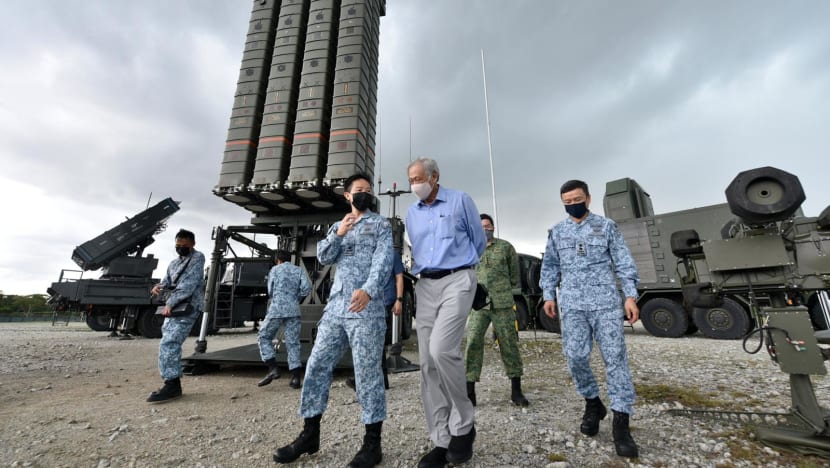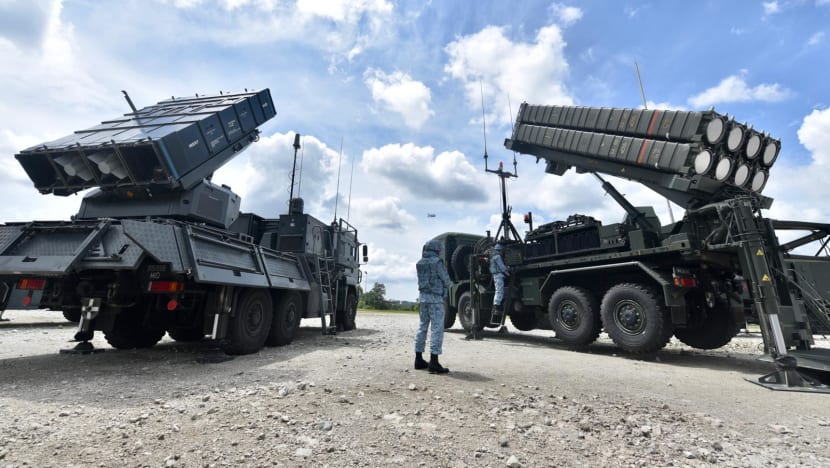commentary Commentary
Commentary: Fighter jets get attention but defending Singapore against rockets and drones require very different tools
The Republic of Singapore has been gradually adding new capabilities and developing its air defence systems but recent developments suggest an upgrade is overdue, says Mike Yeo.

The Aerostat provides 24/7 low-level radar coverage. (Photo: Jeremy Long)
MELBOURNE: Think about aerial threats and the first thing that pops into people’s minds are fighter jets flown by human pilots shooting missiles at each other.
While these are an important, vital, parts of a country’s air defence, there are many airborne threats fighter jets cannot tackle - drone swarms, rockets fired from the ground and cruise missiles to name a few.
This is where ground-based air defence systems come in. Sensors including radars for 360-degree, 24/7 detection of potential airborne threats and shooters can complement the fighter jets overhead.
This ability to deal with an array of threats at different ranges, builds in redundancy so other parts of the system kick in should one fail.
READ: Commentary: They already have jet bombers and super missiles. Will Chinese fighter jets be more powerful than America’s soon?
But also important is the capability for individual sensors and shooters to “talk” to each other, sharing information and data securely so they see the big picture as a whole.
To be this truly multi-layered, comprehensive system that provides a security blanket over Singapore, individual systems must be networked with inbuilt fail-safes providing coverage against different threats at different ranges.
AN ISLAND AIR DEFENCE SYSTEM
Late last year the Republic of Singapore Air Force (RSAF) conducted a demonstration of its networked Island Air Defence System (IADS), a system that came into fruition after some 15 years of development and incremental refinement.
The IADS shown to journalists and defence minister Dr Ng Eng Hen, is a multi-layered, networked, and intelligent Air Defence system which integrates advanced sensors, capable weapon systems, command and control elements, and decision-making tools for defending Singapore against a wide spectrum of threats from the air round-the-clock.

At the heart of the IADS is the Combat Network jointly developed by the RSAF and the Defence, Science and Technology Agency (DSTA), the key part of the system that integrates sensors, the smart Combat Management System (CMS) and weapon systems to increase resilience by preventing a single-point of failure.
The network fuses the picture provided by a variety of sensors such as the various radars operated by the RSAF.
It is also linked to civilian radars and flight plan databases, giving the RSAF a comprehensive understanding of the comings and goings in the airspace around Singapore at any time, crucial for detecting potential airborne threats.
The smart CMS and the Decision Support Systems (DSS) also incorporate technologies such as Artificial Intelligence (AI) and Data Analytics (DA), reducing the cognitive load required of operators to sense-make information from multiple sources for a quicker and more robust decision-making process.
READ: Commentary: Plagued by defence budget curbs - the Royal Malaysian Air Force in crisis
This enables improvements to the sensor-to-shooter loop. The system can evaluate real-time situations to assign the most effective weapon systems, which range from fighter jets to short-range anti-aircraft missiles, to deal with potential air threats.
WHY CONSTANT UPGRADES NEEDED
The importance of modern, integrated air defence system was rammed home once again a few months ago, during the short but deadly war fought by Armenia and Azerbaijan over the disputed territory of Nargono-Karabakh.
Azerbaijan won in no small part due with air dominance over the battlefield, allowing armed drones to operate with near-impunity after effectively destroying Armenia’s unintegrated air defences, picked off one by one, in large part as individual radars and missiles systems were not designed to communicate effectively with each other.
The losses suffered by the Armenians included several units of its vaunted multimillion-dollar Russian-built S-300 long-range surface-to-air missiles (SAM), with the Azerbaijanis releasing several video clips taken from the explosive-packed drones as they dove into the unsuspecting missile launch vehicles.
Many had their onboard radars operating yet were unable to foresee their own demise, much less react.

These older systems were designed to deal with faster, larger conventional aircraft and could not detect the small, relatively slow drones and loitering munitions, designed to stay in the air for hours, circling overhead until a target is found and assigned by operators to crash its explosive-laden body onto it.
These events have shocked defence planners and observers.
It was the first time such armed drones and loitering munitions have been deployed in a conventional, state-to-state conflict on such a scale.
It was a demonstration of the ability of such threats, which may be sometimes older but are relatively cheap to buy and operate compared to aircraft and conventional cruise missiles, to dominate the battlefield when an adversary did not have appropriate countermeasures.
READ: Commentary: Noisy RSAF aircraft and annoyed residents - some compromises are needed
CUSTOMISED FOR SINGAPORE’S NEEDS
Singapore’s IADS was conceptualised in 2006. Since then, the Ministry of Defence (MINDEF) has turned it into reality, gradually developing and adding new capabilities and replacing older, bespoke air defence systems becoming obsolete or less suitable for the IADS.
This meticulous effort underscores Singapore’s policy of taking the long-term view and insisting on sustainable investment when it comes to defence planning and spending.
The concept of such a network itself is not new. Several countries have it in place to defend key targets from air attack, but evolving AI technology and modern datalinks have taken information-sharing within the network to a whole new level.
The latest platform to be integrated into Singapore’s IADS is the Eurosam Aster 30 medium-range SAM, which joined the fold in August and now forms the upper tier of the RSAF’s ground-based air defence system.

Instead of buying off-the-shelf, MINDEF decided to fold the Aster 30 system into radars already forming the sensor network of the IADS, which can provide simultaneous command guidance to multiple missiles, and use a unique truck-mounted guidance radar and datalink system to provide mid-course guidance.
The Aster 30 replaced the Improved HAWK (Homing All the Way Killer) missile in the RSAF’s inventory. It has a longer, 70km range and the added ability to defend against drones and some kinds of ballistic missiles, the latter being a first for Singapore’s defence capability.
RESPONDING TO NEW THREATS
Dr Ng noted that work is not done on the IADS however, as the defence establishment continues to monitor the landscape for new airborne threats and identify potential gaps in coverage in the IADS.
These include not just longer-ranged munitions such as cruise missiles developed by an increasing number of countries which also means a malign state have more sources than ever before.
Dr Ng also highlighted non-traditional threats like terrorists making homebuilt rockets like the Indonesian-based plot uncovered in 2016, or even unlicensed drones that could be purchased via the dark web.
READ: Commentary: We are woefully ill-equipped to deal with rogue drones
An illustration of this was in the waning days of the Islamic State’s caliphate in Iraq and Syria, where home-built, modified commercial drones were employed to drop explosives on enemy forces.
Other insurgent groups have also use similar drones against Syrian government or Russian military forces in Syria’s civil war, both with limited success.
Singapore’s networked IADS must continually be upgraded to ensure that it maintains an effective defence against electronic interference such as jamming or cyber-attacks, a potentially tough challenge as militaries seek to continually improve their capabilities in this domain.
The former has been suggested as a possible reason for Azerbaijan’s success in the recent conflict, with Turkey, who has provided technical, materiel support, and is believed to have supplied long-range jamming equipment to blind Armenian radars and warning systems.
Another recent example of electronic warfare is the Russian support for militants who have conquered a swathe of eastern Ukraine since 2014, with several documented examples of these systems sighted on the battlefield, to jam and disrupt Ukrainian military communications and other systems.

AI-based drone detection systems, while less common, are also now commercially available, equipped with camera-based recognition techniques or radio frequency monitoring to detect drones.
Swarming attacks pose a different threat, as a large number of incoming attackers could overwhelm by numbers, particularly if these utilise a mixture of platforms and approach a target from many directions.
The was the case in 2019 when a mixture of cruise missiles and drones believed to have been launched from Iran-attacked oil facilities in Saudi Arabia, took a circuitous flight path to evade Saudi air defences and came in from an unexpected direction.
READ: In The New Map, author Daniel Yergin takes on energy, climate change and the slow but sure shifts in big power relationships
UPGRADING FOR TOMORROW
While the IADS provides 360-degree coverage of the airspace around Singapore and reduces the likelihood of being surprised by an attack, the RSAF’s ground-based air defences are an all-missile affair. Singapore’s surface-to-air Spyder system, with four missiles, and each Aster 30 system’s eight, could see a sustained swarm attack drain the defender out of ready-to-use missiles.
The obvious solution is a cannon-based system to complement the missiles like the short-range, rapid fire Phalanx close-in weapon system or the Rheinmetall Skyshield that can search, track and engage missile or rocket threats with short, quick bursts of munitions.
Another alternative is the Israeli developed Iron Dome featuring multiple-target tracking and self-guided missile interceptors, to defend against incoming rockets.

The technology for more advanced directed energy weapons holds great potential but is still in its infancy. It will be some time before these are ready for widespread use, but are potentially ways for improving Singapore IADS.
The relatively recent emergence of weapons demonstrate that just because the system appears ready to deal with potential adversaries today, it would be foolish to assume that the status quo would hold in the long or even medium term.
As Dr Ng himself said during his recent visit to the IADS, while the current systems will serve Singapore in the next few decades, the RSAF must continue to look at steady improvements and remain cognisant of gaps to fill.
Mike Yeo is the Asia reporter for US-based defence publication Defense News.














